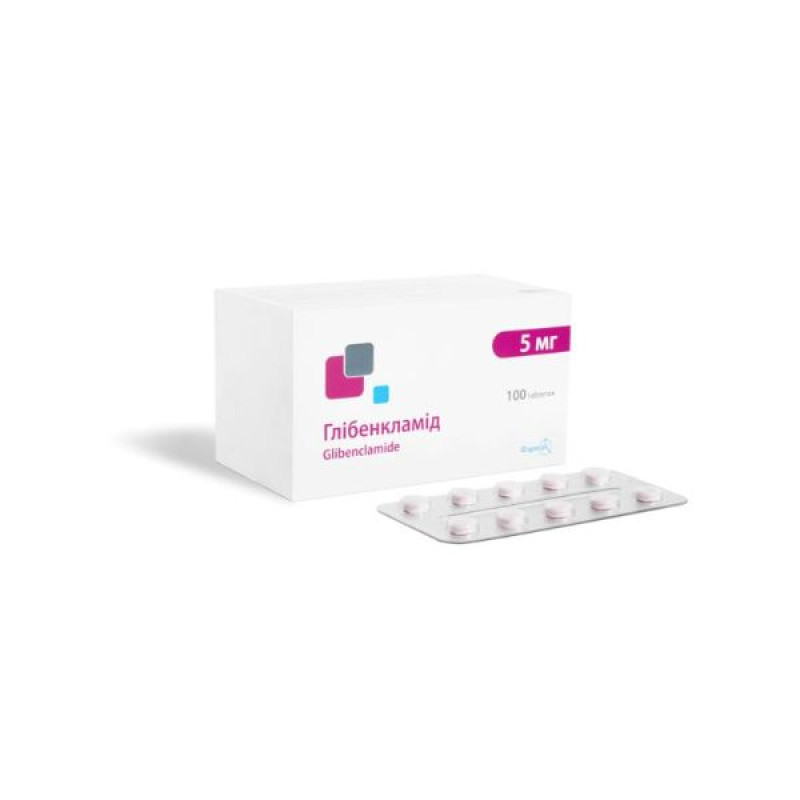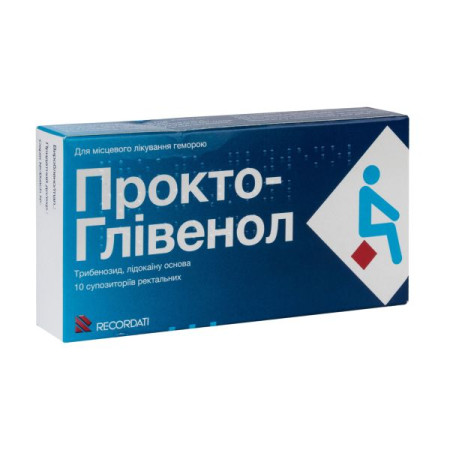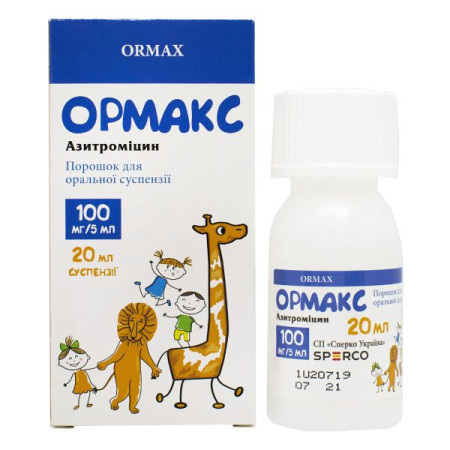Glibenclamide tablets 5 mg No. 100

Pharmacological properties
Pharmacodynamics. refers to oral hypoglycemic agents, sulfonylurea derivatives of the 2nd generation. promotes stimulation of β-cells of the pancreas, which is accompanied by mobilization and increased release of endogenous insulin. The drug is effective in the presence of functionally capable β-cells in the pancreas that produce endogenous insulin. helps reduce platelet aggregation.
Pharmacokinetics. When glibenclamide is taken orally on an empty stomach, it is rapidly and almost completely absorbed in the gastrointestinal tract. The drug is more than 98% bound to blood proteins (albumin) and is metabolized in the liver. During metabolism, 3-cishydroxyglibenclamide and 4-transhydroxyglibenclamide are formed. It is excreted from the body with urine and bile. T ½ glibenclamide from blood plasma is 1.5-3.5 hours. The hypoglycemic effect lasts up to 12 hours.
In patients with reduced liver function, the elimination of the drug is slowed down. In conditions accompanied by moderate renal insufficiency (with creatinine clearance of 30 ml/min), the process of excretion of metabolites does not change, but their cumulation is possible in severe renal insufficiency.
Indication
Non-insulin-dependent diabetes in adults (type 2 diabetes mellitus), if other measures, such as strict adherence to a diet, weight loss, and sufficient physical activity, have not led to satisfactory correction of blood glucose levels.
Application
The drug should be used only as prescribed by a doctor and always with diet correction. The dosage depends on the results of metabolic status tests (blood and urine glucose levels).
First and subsequent appointments. Therapy should be started with the lowest possible doses, especially in patients with a high susceptibility to hypoglycemia and a body weight of less than 50 kg. The first appointment is from ½ to 1 tablet (corresponding to 2.5-5 mg of glibenclamide) per day. If the metabolism is not sufficiently corrected, the dose is gradually increased at intervals of several days to one week to the required daily therapeutic dose of 3 tablets (corresponding to 15 mg of glibenclamide) per day.
Transferring a patient from other antidiabetic drugs. Transferring to Glibenclamide should be done very carefully and start with ½ to 1 tablet (corresponding to 2.5-5 mg of glibenclamide per day).
Dose selection. In elderly, debilitated or malnourished patients, as well as in patients with mild to moderate renal or hepatic impairment, the initial and maintenance doses should be reduced due to the possibility of hypoglycemia. If the patient's body weight decreases or lifestyle changes, the question of dose adjustment should be addressed.
Combination with other antidiabetic agents. In justified cases, patients with metformin intolerance may be shown additional administration of glitazones (rosiglitazone, pioglitazone). Glibenclamide can be combined with oral antidiabetic agents that do not stimulate the release of endogenous insulin by β-cells (guarmel or acarbose). In case of secondary ineffectiveness of glibenclamide therapy (decreased insulin production as a result of decreased β-cell activity), combined treatment with insulin can be tried. However, with complete cessation of the body's own insulin secretion, insulin monotherapy is indicated.
Method and duration of treatment. Tablets should be taken before meals. Do not chew and drink plenty of liquid (preferably 1 glass of water). With a daily dose of more than 2 tablets of the drug, it is recommended to divide the entire amount into one morning and one evening dose in a ratio of 2: 1. It is very important to use the drug at the same time each time. If the patient misses one dose, it should never be supplemented by taking a higher dose. The duration of treatment depends on the course of the disease. During treatment, regular monitoring of the metabolic state is required.
Contraindication
Hypersensitivity to glibenclamide or excipients, sulfonylurea derivatives, sulfonamides, diuretics, sulfonamide derivatives and probenecid. in cases where insulin treatment is required: type I diabetes mellitus, complete secondary ineffectiveness of glibenclamide therapy in type II diabetes mellitus, metabolic disorders leading to acidosis, precoma or diabetic coma. condition after pancreatic resection. severe liver dysfunction. severe renal dysfunction.
Side effects
When assessing adverse reactions, the following frequency values were used as a basis: very common (≥10%), common (10%, ≥1%), uncommon (1%, ≥0.1%), rare (0.1%, ≥0.01%), very rare (0.01% or cases unknown).
Metabolism and nutrition disorders: often - hypoglycemia, weight gain.
Visual disturbances: very rarely - visual and accommodation disorders, especially at the beginning of treatment.
Liver and gallbladder disorders: very rarely - transient increases in AST and ALT, alkaline phosphatase, drug-induced hepatitis, intrahepatic cholestasis, which may be caused by an allergic reaction of the hyperergic type of liver cells. These disorders are reversible after drug withdrawal, but can lead to life-threatening liver failure.
Skin and subcutaneous tissue disorders: sometimes - itching, urticaria, erythema nodosum, crust-like or maculopapular rash, purpura, photosensitivity. These hypersensitivity reactions are reversible, but very rarely can develop into life-threatening conditions, accompanied by shortness of breath and a decrease in blood pressure, up to the development of shock. Very rarely - generalized hypersensitivity reactions, accompanied by a rash on the skin, joints, fever, proteinuria and jaundice; allergic vasculitis, which is life-threatening. If skin reactions occur, you should consult a doctor.
Blood and lymphatic system disorders: rarely - thrombocytopenia. Very rarely - leukopenia, erythropenia, granulocytopenia, up to the development of agranulocytosis. In some cases - pancytopenia, hemolytic anemia, aplastic anemia, eosinophilia. The above changes in the blood picture are reversible after discontinuation of the drug, but very rarely can be life-threatening.
Other side effects: very rarely - weak diuretic effect, syndrome of inappropriate secretion of antidiuretic hormone, reversible proteinuria, hyponatremia, disulfiram-like reaction, cross-allergy with sulfonamides, sulfonamide derivatives and probenecid. Ponceau 4R may cause allergic reactions.
Special instructions
Special caution is required when using the drug in patients with mild or moderate renal or hepatic impairment or reduced thyroid, pituitary or adrenal function.
Elderly patients are at risk of developing prolonged hypoglycemia, so glibenclamide is prescribed to them with special caution and their condition is carefully monitored at the beginning of treatment. In this age group, under certain conditions, it is more expedient to initially use sulfonylureas with a shorter duration of action. Diabetic patients with signs of cerebral sclerosis and patients with whom contact is generally difficult are more prone to the threat of developing hypoglycemia. Long intervals between meals, insufficient carbohydrate intake, unusual physical activity, diarrhea or vomiting can increase the risk of developing hypoglycemia.
With the simultaneous use of Glibenclamide with clonidine, β-adrenergic blockers, guanethidine and reserpine, the patient's perception of symptoms - precursors of hypoglycemia may be impaired.
The effect of the drug Glibenclamide may be unpredictably increased or decreased when alcohol is consumed repeatedly in large quantities and with its constant use.
Constant abuse of laxatives can lead to a deterioration in metabolic status.
If the treatment regimen is not followed, the hypoglycemic effect of the drug is insufficient, or there are stressful situations (trauma, surgery, infectious disease accompanied by an increase in body temperature), the blood glucose level may sometimes increase to such an extent that a temporary transfer of the patient to insulin may be required. Symptoms of hyperglycemia may include a feeling of intense thirst, dry mouth, frequent urination, itching, dry skin, fungal or infectious skin diseases, and decreased performance. The patient should be aware that if other diseases appear during treatment with Glibenclamide, he should immediately consult a doctor.
In patients with glucose-6-phosphate dehydrogenase deficiency, treatment with sulfonylurea drugs, including glibenclamide, can cause hemolytic anemia, so the issue of switching to drugs alternative to sulfonylurea derivatives should be addressed.
Glibenclamide should not be used in patients with hereditary galactose intolerance, lactase deficiency or glucose-galactose malabsorption syndrome.
Use during pregnancy and breastfeeding. The use of glibenclamide in pregnant women and during breastfeeding is contraindicated.
Children: Do not use in children.
Ability to influence the reaction rate when driving or operating other mechanisms. Patients should take precautions to prevent hypoglycemia when driving or operating other mechanisms. This is especially important for those patients who often have hypoglycemia or lack symptoms that are precursors of hypoglycemia. In such cases, it is necessary to decide whether it is appropriate to drive a vehicle.
Drugs that enhance the effect of glibenclamide when used simultaneously: other antidiabetic drugs and insulin, ACE inhibitors, anabolic steroids and male sex hormones, antidepressants (fluoxetine, MAO inhibitors), β-adrenoceptor blockers, quinolone derivatives, chloramphenicol, clofibrate and its analogues, coumarin derivatives, disopyramide, fenfluramine, miconazole, PAS, pentoxifylline (administered parenterally in high doses), perhexiline, pyrazolone derivatives, probenecid, salicylates, sulfonamides, tetracycline antibiotics, tritoqualine, cytostatics such as cyclophosphamide.
Drugs that reduce the effect of glibenclamide when used simultaneously: acetazolamide, β-adrenergic blockers, barbiturates, diazoxide, diuretics, glucagon, isoniazid, corticosteroids, NICOTINATE, phenothiazine derivatives, phenytoin, rifampicin, thyroid hormones, female sex hormones (gestagens, estrogens), sympathomimetics.
H2-receptor blockers, clonidine and reserpine can both reduce and enhance the hypoglycemic effect of the drug. In some cases, pentamidine can lead to severe hypoglycemia or hyperglycemia. The effect of coumarin derivatives can both increase and decrease.
Overdose
A single overdose or the use of slightly increased doses over a long period of time can lead to severe prolonged hypoglycemia, which is life-threatening.
Symptoms of overdose (hypoglycemia): sudden sweating, increased heartbeat, tremor, feeling of hunger, anxiety, paresthesias in the mouth, pale skin, headache, drowsiness, sleep disorders, timidity, uncertainty in movements, temporary neurological disorders (impaired speech and vision, the appearance of paralysis or impaired sensitivity). With progressive hypoglycemia, the patient may lose control of his condition and lose consciousness (hypoglycemic shock). In such cases, the skin is moist and cold to the touch, tachycardia, hyperthermia, motor excitement, hyperreflexia, paresis and a positive Babinski reflex are noted, convulsions may occur.
Treatment. Mild or moderate hypoglycemia can be treated by the patient himself by consuming sugar, food or drinks with a high sugar content. If hypoglycemia is severe, it is necessary to immediately seek medical help. In case of accidental poisoning and provided that contact can be established with the patient, vomiting should be induced, gastric lavage should be performed (in the absence of a tendency to convulsions) and glucose should be administered intravenously. If the patient has lost consciousness, intravenous glucose administration should be immediately started (40-80 ml of a 40% solution in the form of an injection, followed by an infusion of 5-10% glucose solution). If necessary, 1 mg of glucagon can be additionally administered intravenously or intramuscularly. If the patient does not regain consciousness, these measures are repeated, and intensive therapy may be required in the future. Prolonged hypoglycemia requires monitoring of the patient for several days with regular monitoring of blood glucose levels and, if necessary, infusion therapy.
Storage conditions
In a place protected from light at a temperature not exceeding 25 °C.
There are no reviews for this product.
There are no reviews for this product, be the first to leave your review.
No questions about this product, be the first and ask your question.








